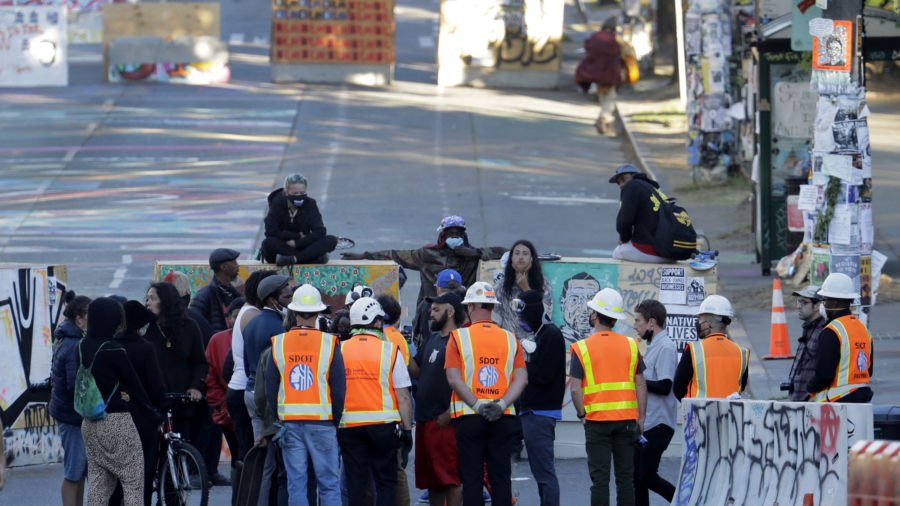People occupying a so-called autonomous zone in Seattle blocked city workers from removing barriers, leading to a meeting on Friday with Mayor Jenny Durkan.
Employees from multiple departments arrived outside the zone early Friday morning “to continue the recovery of the Capitol Hill neighborhood, with the goal of removing some additional barriers blocking the roadways and cleaning up Cal Anderson Park,” a city spokesperson told The Epoch Times in an emailed statement.
“Once this work commenced to remove some of the barriers blocking roadways, City workers were met with significant resistance by protesters, who grew increasingly agitated and aggressive towards City workers.”
Protesters are refusing to leave until their demands are met. The demands include abolishing the Seattle Police Department, reparations for “victims of police brutality,” and a retrial of all minorities currently in prison for violent crimes.
Plans are being made on how to safely transition the area, known as the Capitol Hill Organized Protest (CHOP), from the occupation to normal operations.
Durkan, a Democrat, announced Monday the city would dismantle the zone after a steady increase in violence, including a fatal shooting. She had previously expressed support for the occupation, claiming it could lead to a “summer of love.”
The zone includes an abandoned Seattle Police Department precinct. After police left the building on June 8, protesters streamed into the area, moving barricades across city streets and blocking traffic.



Response times to crimes soared, according to Police Chief Carmen Best. The lawlessness forced local businesses to close as occupiers intimidated residents, prospective customers, employees, and delivery drivers, a class action lawsuit filed against city officials said.
Officials were supposed to publicly outline plans to dismantle the zone by Saturday or lawyers representing the plaintiffs would file a court order, but the lawyers agreed not to file the order, the Seattle City Attorney’s office said.
The Seattle Police Department didn’t return to the East Precinct on Friday, the city spokesperson told The Epoch Times. A mayoral spokesperson told the Associated Press that there are no plans to return to the precinct this weekend.
The continued standoff led to Durkan meeting with CHOP organizers Friday evening. She did not speak to reporters afterward.
The mayor’s office said in a statement after the meeting that Durkan met with organizers “to discuss the restoration of the Capitol Hill area and long-term changes to transform policing.”
“The City’s goal remains to allow any individuals to exceed use their first amendment rights while also preserving the public safety of local residents and small businesses. The Mayor suggested a series of steps that she believes can be taken in the coming days, including the removal of the barriers to create more access. She also believes in the planning for some of the long term changes to Cal Anderson including art installations and the community garden,” it added.
City officials are working to help any occupiers who need assistance accessing shelter, healthcare, food, COVID-19 testing, or mental health services and representatives planned to return to the site on Saturday.
From The Epoch Times

